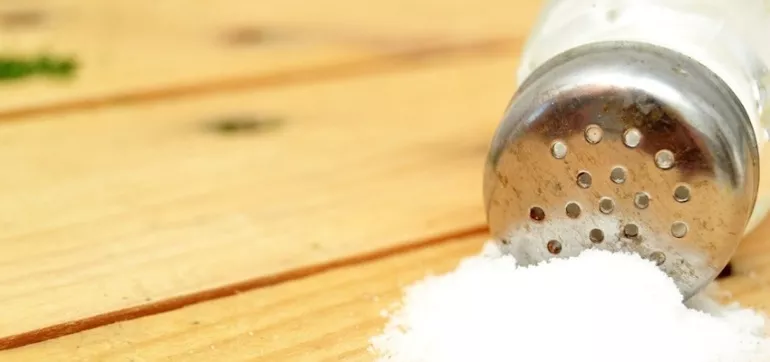
In recent months, there’s been a lot of talk about the dangers of eating too much sugar or fat, but it seems like everyone forgot to address salt. I’d like to encourage you to think twice about your salt intake, as excess processed salt is associated with high blood pressure, heart disease and stroke.
Refined salt is easy to spot and control in a shaker or on a chip, but it’s not so easy to identify in many processed foods, restaurant items, or kitchen staples. If you’re looking to reduce your sodium intake to improve your health, as is recommended in the popular DASH diet, then you might want to keep an eye on these six items.
1. Processed red meats.
Packaged ham, bacon, sausage, turkey and many deli meats are high in sodium as it’s added to preserve the meat from spoilage. A serving may have over half of the day’s recommended sodium load (usually about 2,000 mg a day). But processed meats aren’t just bad because they have a lot of sodium! Keep in mind that they’re associated with earlier mortality, breast cancer, heart failure, colorectal cancer and other disease. In general, this is a good food group to avoid.
2. Poultry.
Sodium is often injected into poultry during processing. You’ll certainly find higher levels in nuggets and other “convenience” poultry foods. A small serving (3 ounces) of nuggets may have over 25% of the daily recommended sodium load. Read labels when buying chicken in the grocery store as it may help you make better choices.
3. Soup.
My pet peeve is hospital food and I often see a bowl of vegetable soup with over half of the day’s sodium load. Ouch! Especially if you want to walk out of there healthy! Many canned chicken noodle soups also have about 1,000 mg of sodium. If you want soup, make it yourself or carefully read the label before buying and opt for the one with the least amount of sodium.
4. Pizza.
The dough and cheese of a typical slice have over a third of the day’s recommended sodium load. (And who eats just once slice?) Then there’s the fat and sugar found in most prepared pizzas. Ask questions, cut back, or skip the cheese in favor of more veggies. Better yet, make your own at home.
5. Bread and rolls.
Store bought bread is a hidden source of refined salt and by some measures, it’s the number one source of salt in the average diet. If a slice of bread has about 230 mg (on average), getting nearly half of your day’s sodium load from bread and baked goods is far too easy. Even bread that doesn’t taste salty can have quite a lot of salt. Again, be sure to read labels, selecting brands with lower amounts of sodium.
6. Sandwiches.
Of course, the bread of a sandwich will be a source of sodium, but if the fillings are packaged turkey and cheese, a single meal could provide nearly all of your sodium for the day. A better option: open-faced sandwiches with lettuce, tomatoes, avocados and cucumbers (instead of cheese or a pile of meat). This will reduce the sodium dramatically.
Salt can enter your diet in other sneaky way, including through some medications, MSG, baking powder, sodium nitrates in cured meats, sodium sulfites used to treat dried fruits like prunes, and sodium propionate used in pasteurized cheeses.
To cut back on your sodium intake:
- Avoid processed, prepared, and pre-packaged foods.
- Choose lower sodium versions of foods.
- Read food labels.
- Eat fruit and vegetables as snacks.
- Choose unsalted nuts and seeds.
- Avoid canned vegetables and soups high in salt, you can reduce your intake easily.
Herbs and spices not only give flavor to foods in place of salt, but they also add tremendous antioxidant benefits to make many meals super healthy.
Over 100 years ago British writer William Hazlitt wrote that “wit is the salt of conversation, not the food.” For the health of your heart and arteries, avoid these hidden causes of salt and replace them with spices and wit.
Originally posted on MindBodyGreen.com

